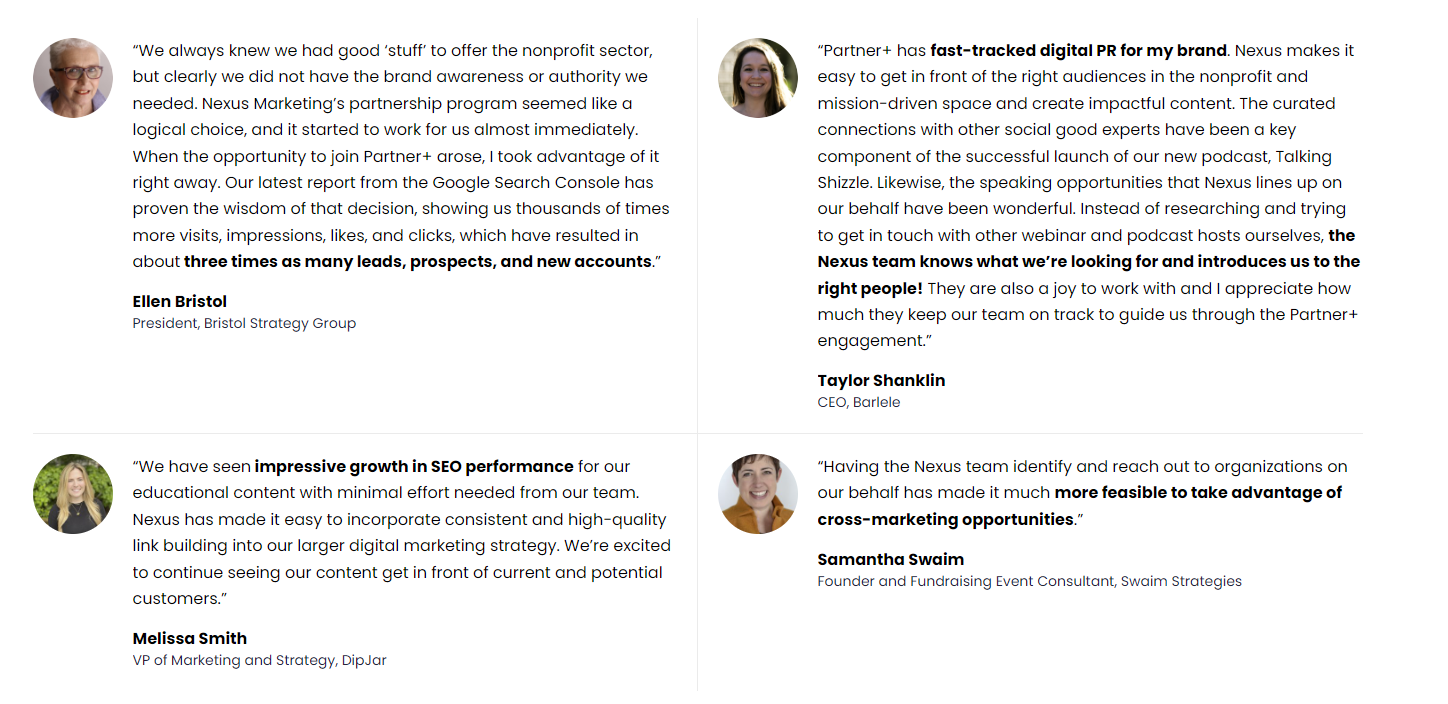
A publishing partnership with Nexus Marketing is a great way to boost the overall SEO health of your website and save a ton of time along the way.
Once your partnership is going strong, what additional steps can you take to maximize the SEO value for your website? We have a few tips.
1. Use our content as a model for your own.
When you write new content for your blog, take a look at the technical elements included in the drafts you receive from Nexus Marketing. These include:
- Meta descriptions
- Alt text for images
- Titles fewer than 60 characters long
- Intuitive headings that break up sections and include keywords
- A variety of internal and external links
By including these elements in the content that you write, you make it easier for Google and users to quickly understand and trust what you have to say.
2. Build internal links to your own content.
By linking to important pages of your website on other pages of your website, you help Google more efficiently crawl and understand your website’s content.
Nexus Marketing includes links to your content throughout the articles that you receive for this reason—it’s a super easy way to passively improve the SEO power of a website domain.
To get started, identify the most important SEO pages on your website, those that already rank for keywords (Nexus can help you do this). Determine which keywords they’re ranking for, and then find other pages on your website that don’t yet link to them. Edit those pages to include new links in natural ways, using intuitive anchor text that makes it clear to readers what they’ll be clicking through to.
3. Make your URLs short and sweet.
When you publish new pages or blog posts on your website, give them URLs that are concise and include a keyword. Don’t use the full title of the content as the URL. Consider these two examples:
- www.yourwebsite.com/blog/a-full-calendar-of-fun-12-year-round-fundraising-ideas-for-community-nonprofits/
- www.yourwebsite.com/blog/year-round-fundraising-ideas/
The second URL gives a much quicker and more direct idea of what the content is about, and Google would agree! This is why we provide suggested URLs in the content we write for your blog.
This approach makes it much easier to maintain an organized, more helpful catalog of content. Plus, you’ll be able to update and expand content to target those primary keywords, making your pages more comprehensive over time.
Think one of your blog posts would be a good starting point for a comprehensive, SEO-optimized article? Ask your Nexus Content Publishing Coordinator about planning a refresh for it!
4. Keep your content mobile-friendly.
Did you know that the majority of web traffic now comes from smartphones? The mobile usability of web content is increasingly important for SEO.
In recent years, Google has begun crawling the mobile version of web pages to check for quality before it considers the desktop version. This is called mobile-first indexing, and its purpose is to improve the overall mobile usability of Google results by prioritizing pages that offer the best mobile experiences.
Some elements of mobile optimization might require the help of a developer, but there are plenty of steps you can take on your own.
Start by running a Google PageSpeed Insights report on one of your blog posts, and check out any specific performance issues and opportunities that it flags.
5. Join an NXUnite panel.
Have you attended or participated in an NXUnite panel discussion yet?
NXUnite is Nexus Marketing’s online community that connects our partners in the mission-driven sector with broader audiences of nonprofit professionals. We host a ton of free webinars and panels for mission-driven experts to share their thoughts and discuss trends—check out our calendar to see what’s up next!
If you’re interested in joining an NXUnite panel and exposing your brand to wider audiences, please get in touch to learn more. We also offer sponsorship opportunities for brands to host their own webinars for the NXUnite community.
6. Publish a mix of new and updated content.
Keeping your blog fresh and active with new content is important, but so is maintaining the overall quality of your content catalog.
If there are pages on your blog that you know have SEO value, check to see when they were last updated. In most cases, Google strongly prefers content that’s both comprehensive and fresh. By making periodic updates to improve and expand your content, you can accomplish both!
Updating older content also brings the benefit of retaining any external links that have been built to it over time, an important part of the SEO equation.
Nexus Marketing can help you identify pages on your site that already rank for keywords, and we can plan refreshes to keep them in top shape.




